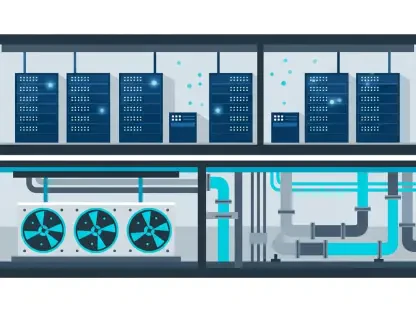In the heart of Spotsylvania County, Virginia, a pivotal decision by the Board of Supervisors to approve a sprawling 2.2-million-square-foot data center campus at Hunters Ridge South has ignited a fiery debate about the intersection of technological advancement and community well-being, highlighting a broader national tension. Passed with a 5-2 vote, this project exemplifies the strain data centers—facilities that power the digital age—place on local resources and patience. On one hand, these hubs promise substantial economic boosts through revenue and infrastructure development; on the other, they provoke significant concerns about environmental impact, noise pollution, and the erosion of suburban tranquility. As communities like Spotsylvania grapple with rapid industrial growth, the question looms large: can the tech industry’s relentless expansion harmonize with the needs and values of local residents? This clash of priorities sets the stage for a deeper exploration of how such developments are shaping the future of small counties across America.
Economic Benefits in the Spotlight
The argument for data centers in Spotsylvania County often centers on their potential to transform the local economy, a perspective championed by several supervisors during the recent board meeting. Supervisor Deborah Frazier emphasized the county’s pressing budget constraints, pointing to a staggering $930 million in infrastructure improvements projected from Amazon as a critical lifeline. Beyond mere dollars, data center projects often come with additional perks, such as commitments to fund road construction and contributions to educational initiatives like a $100,000 donation to the local Career and Technical Center. For a county wrestling with rising real estate and personal property taxes, these benefits represent a tangible way to alleviate financial burdens on residents while paving the way for long-term growth. The allure of fiscal stability through tech industry partnerships is a compelling driver, positioning data centers as a strategic investment in the county’s future amidst competing demands for public resources.
However, the economic promise of data centers is not without its complexities, as the benefits must be weighed against the immediate and long-term costs to the community. While the influx of revenue can offset tax increases, it often comes with strings attached, such as the need for significant upgrades to the electrical grid and water systems to support these power-hungry facilities. Critics within the board, alongside concerned citizens, argue that the financial gains might be overshadowed by the strain on infrastructure, which could lead to higher maintenance costs down the line. Moreover, the jobs created by data centers are often highly specialized, leaving little room for local employment opportunities. This disparity raises questions about whether the economic windfall truly trickles down to the average resident or remains concentrated among a select few. The debate in Spotsylvania highlights a critical need to scrutinize the full scope of economic impacts before embracing such large-scale industrial projects.
Community Resistance and Environmental Fears
Opposition to the Hunters Ridge South project in Spotsylvania County has been vocal and multifaceted, reflecting deep-rooted concerns about quality of life and environmental health. During the board meeting, residents articulated their apprehensions over noise pollution from constant cooling systems, potential threats to the water supply due to high usage, and the strain on the electrical grid that could lead to outages or higher utility costs. There’s also a lingering fear about the visual and ecological blight that decommissioned data centers might leave behind, tarnishing the county’s cherished rural and suburban landscape. These issues resonate beyond mere inconvenience, touching on fundamental worries about preserving the character of a community under pressure from rapid industrialization. The public’s resistance signals a broader unease about sacrificing long-term sustainability for short-term economic gains.
Supervisors like Lori Hayes and Jacob Lane have amplified these community concerns, advocating for a more cautious approach to data center approvals. Hayes, in particular, pushed for a delay in the vote to facilitate further discussions with industry experts and the planning commission, underscoring the importance of protecting natural resources such as wetlands. Her stance reflects a commitment to ensuring that development does not come at the expense of environmental integrity or resident well-being. Lane’s opposition similarly highlights a protective instinct toward constituents, prioritizing their immediate needs over speculative benefits. This resistance within the board underscores a significant divide, revealing that while economic arguments hold weight, they must be balanced against legitimate fears about the irreversible impacts of industrial sprawl. The tension in Spotsylvania serves as a microcosm of the challenges faced by many communities navigating the tech industry’s footprint.
Bridging the Gap with Transparency
A key issue emerging from the Spotsylvania debate is the role of misinformation in fueling public opposition to data centers, a concern acknowledged by both industry representatives and county officials. Charlie Payne, an attorney representing data center applicants, expressed frustration over what he perceives as unfounded fears driving resistance, noting that the county has actively recruited this industry for over a decade. His call for a focus on factual information aligns with the board’s unanimous decision to schedule a joint session on September 23 with key stakeholders, including Amazon Web Services, Dominion Power, and the planning commission. This event aims to provide clarity on the industry’s impacts and benefits, offering a platform to address myths and misconceptions. Such an initiative represents a critical step toward fostering trust, ensuring that community apprehensions are met with data-driven responses rather than dismissive rhetoric.
The upcoming joint session holds promise as a mechanism for dialogue, potentially easing the polarized atmosphere surrounding data center projects in Spotsylvania County. By bringing together industry leaders, utility providers, and local officials, the event could demystify technical aspects like power consumption and water usage, which often fuel public skepticism. More importantly, it offers residents a chance to voice lingering doubts directly to those shaping these developments, creating a space for accountability. Supervisors like Kevin Marshall, who proposed the session, recognize that informed discourse is essential to reconciling economic aspirations with community values. If successful, this approach could set a precedent for other regions facing similar dilemmas, demonstrating that transparency and education are vital tools in navigating the complex interplay of tech growth and local priorities. The outcome of this session may well influence how future projects are perceived and managed.
Pathways to Sustainable Coexistence
Reflecting on the Spotsylvania Board of Supervisors’ decision to greenlight the Hunters Ridge South data center campus, it’s evident that the 5-2 vote marked a significant moment of contention and compromise. The split decision, coupled with passionate public critique, painted a picture of a county eager to harness technological progress yet wary of its repercussions on daily life. The unanimous support for an educational joint session hinted at a collective desire to move beyond discord toward understanding, setting the stage for a more informed debate. Looking back, the diverse viewpoints among supervisors and residents—from economic pragmatism to environmental caution—underscored the intricate challenges of industrial expansion in smaller communities.
Moving forward, Spotsylvania County must prioritize actionable strategies to ensure data centers and community interests align. Establishing clear guidelines for environmental mitigation, such as strict limits on water usage and noise levels, could address key public concerns. Additionally, creating ongoing forums for resident input would maintain transparency, preventing future projects from becoming flashpoints of opposition. Collaborating with industry players to fund local job training programs might also ensure that economic benefits are more inclusive. As other counties watch Spotsylvania’s journey, the lessons learned here could shape broader policies, offering a blueprint for integrating tech growth with community preservation through proactive engagement and balanced planning.









